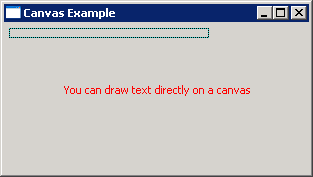- The GC class (short for graphical context) forms the core of SWT's graphics engine.
- GC offers all the methods required for drawing shapes, text, and images.
- You can draw on Controls, Devices, or other Images.
Generally, drawing lifecycles consists of the following:
- Creating or obtaining a GC to draw on the desired target
- Drawing
- If you created the GC, disposing the GC
In code, the drawing lifecycle looks like this:
GC gc = new GC(display);
gc.drawRectangle(...);
gc.drawText(...);
gc.drawImage(...);
gc.dispose();
You generally put drawing code in a paint handler, like this:

import org.eclipse.swt.SWT;
import org.eclipse.swt.events.PaintEvent;
import org.eclipse.swt.events.PaintListener;
import org.eclipse.swt.graphics.GC;
import org.eclipse.swt.layout.FillLayout;
import org.eclipse.swt.widgets.Canvas;
import org.eclipse.swt.widgets.Display;
import org.eclipse.swt.widgets.Shell;
public class GCCreateFrom {
public static void main(String[] args) {
Display display = new Display();
Shell shell = new Shell(display);
shell.setText("Canvas Example");
shell.setLayout(new FillLayout());
final Canvas canvas = new Canvas(shell, SWT.NONE);
canvas.addPaintListener(new PaintListener() {
public void paintControl(PaintEvent e) {
GC gc = new GC(canvas);
gc.setForeground(e.display.getSystemColor(SWT.COLOR_RED));
gc.drawFocus(5, 5, 200, 10);
gc.drawText("You can draw text directly on a canvas", 60, 60);
gc.dispose();
}
});
shell.open();
while (!shell.isDisposed()) {
if (!display.readAndDispatch()) {
display.sleep();
}
}
display.dispose();
}
}